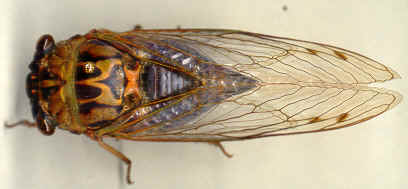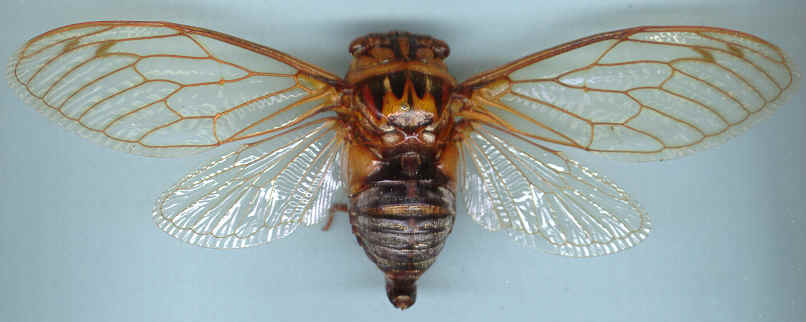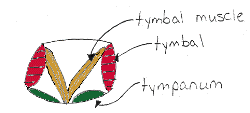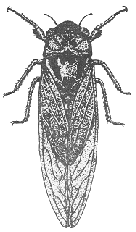|
HOME |
|
|
HOME |
|
Weeee-oh, weeee-oh, weeee-oh, weeee-oh, weeee-oh, weeee-oh, weeee-oh - - - from late afternoon to dark, the male Cicadas call from their perches in the trees to attract a mate. Starting in mid-summer and continuing for about two months the choruses of these noisy insects tell us it is summer.

METAMORPHOSIS
Cicadas are members of the Insect order Homoptera. Other insects in the same order are Aphids, Scale Insects, Leafhoppers, and Treehoppers. Homopterans have a short, piercing/sucking mouthpart which looks like a hypodermic needle and their wings are clear for their entire length.
Both the Homoptera and the Hemiptera have incomplete metamorphosis, where the egg hatches into a nymph that grows through several stages called instars until it finally transforms into the adult stage. Adults can reproduce and have wings. There are many different species of cicada, and they come in many different sizes.
Cicada nymphs burrow underground and feed on sap from plant roots. The length of time they spend undergrounds is from 2 to 17 years, depending on the species. The nymphs have large, muscular front legs for all this digging.
When they are ready to become adults, the nymphs tunnel to the surface and crawl up on the side of the nearest object. Then the skin splits down the middle of their back and they emerge to inflate and dry their wings. This is done at night.

The Annual Cicada is called this because the species may be seen every year. The length of time it spends underground varies from 2 to 5 years, so some emerge every summer. They are about 2cm long.
LISTEN TO THE MUSIC!
How loud are cicadas? Some have been measured at 100 decibels at 20 metres away, which is loud enough to be heard over a lawnmower!

How do they make all that racket? On the underside of the abdomen at the front are two stiff membranes called tymbals. If you turn a male on its back you will see two shield-like structures just under the hind legs. The tymbals are underneath these structures. They have a special muscle attached to them and by rapidly contracting and relaxing the muscle - up to 400 times per second! - the tymbal is "popped" back and forth, much like pushing down and then releasing the top of an empty softdrink can. The cicada's special muscle gets tired after a while and the insect then stops to rest. This is what happens when you hear the buzz of a cicada sputter to a halt. Each species of cicada has a distinct song.
A DANGEROUS LIFE
The cicada chorus is used to attract the females. This is a risky business for the male because it advertises his presence to predators also! And there are LOTS of predators of cicadas. Many species of birds, eat cicadas every chance they get. As you might guess by their lack of bright colors, cicadas do not have any special defense other than camouflage or flying away from danger. By emerging from the ground in huge numbers over a short period of time, they succeed because there are so many of them. Enough will always survive to ensure the production of the next generation.

After mating, the female woodland cicadas use their specially modified ovipositors to cut short slits in the twigs of the trees they are in. They lay their eggs in the slits and the young nymphs drop to the ground when they hatch.
An interesting thing to listen for on an evening walk in late summer is the end of the cicada chorus, which comes at dark. One by one, the males stop for the day and then you can hear the quieter night-calling insects such as crickets and katydids. The relief we feel as the heat of the day subsides goes along nicely with the growing silence as the cicadas quit calling.